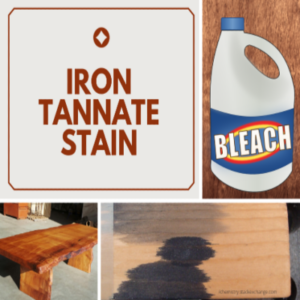Iron Tannate Stain

Iron tannate stain is a result of a chemical reaction between tannins, moisture, and iron. The stain can look like mildew. Iron stain is most common in red oak wood and can ruin the aesthetics of flooring, paneling, furniture, kitchen cabinets, etc. made from this species. It is a problem both during kiln drying and also secondary (value-added) processing.
The Cause
Red oak has tannic acid in it. Iron tannate stain is a chemical stain which occurs as tannic acid oxidizes with the iron fragments from the steel wool. Steel wool fractures and leaves minute particles all over the wood. This stain typically occurs more frequently in the areas where the wood grain is coarser (more porous).
There are a few other ways to help decide if the stain is mildew or iron-tannate. The first of these is to wipe the surface with bleach, like Clorox or Purex. If the spots disappear, the problem is mildew. If not, it is probably iron-tannate stain. If you look at the doors of the cabinet, look to see if the color occurs on both the underside of the top rail and the top side of the bottom rail. If it does not occur on the underside of the top rail, it is iron-tannate stain.
For kiln drying operations, typical iron sources are rusty metal in the kilns (roof vents, fan floors, etc). Water will condense on these iron items and then drip on the lumber. Rusty, iron steam spray pipes can also cause iron stain. For cabinets and furniture operations, steel wool is the culprit. When steel wool is used to sand wood, small fibers of the steel wool will drop onto the floor, counter top, or lower door rails. If the top side of the bottom rail shows a much higher concentration of the stain, it is probably due to these fibers of the steel wool that have dropped and landed on the rail, and the prognosis is iron tannate stain. Another visual method to determine if iron-tannate stain is the culprit, is to look closely at the spots. If the spots are odd-shaped (semi-circular or linear), then it is probably iron-tannate stain. Mildew generally only occurs as small splotches. The other way to accurately determine if mildew is present, is to look at a small section of the wood under a microscope. Mildew will have hyphae (root-like structures of fungi), which iron-tannate stain will not.
The Solution
The only way to remove iron-tannate stain from the red oak lumber is to use oxalic acid. Oxalic acid is a strong bleaching agent and will bleach the oxidization from the surface of the wood. It is recommended that the sealer (lacquer, varnish, polyurethane) be removed prior to using the oxalic acid for best results. The oxalic acid might or might not work through such a finish. The best control method is to eliminate the source of the iron either in the dry kiln (rusty water) or during secondary processing (steel wool).
Meet the Author
Dr. Todd Shupe is the President of Wood Science Consulting, LLC. He is a well-recognized expert on wood forensics, wood preservation, wood decay and degradation, and wood species identification. He has a broad background in new product development, quality management, and marketing and sales in both the public and private sectors. For more information please visit DrToddShupe.com.
We welcome your comments below.
Thank you for visiting. We trust that you have enjoyed reading our articles.
Liked this post? Read more below or search for more topics . . .

